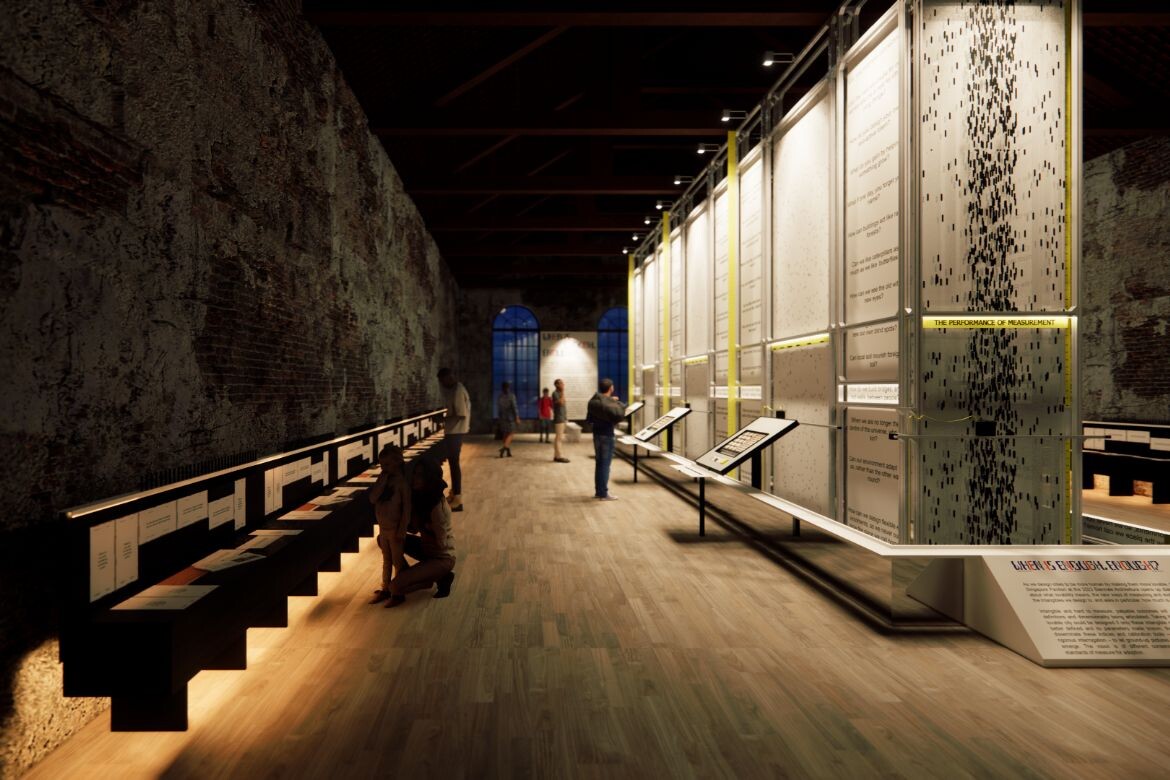Happening from 20 May to 26 November, the Singapore Pavilion at the 18th Venice Architecture Biennale opens up dialogue about new ways of measuring and evaluating the intangibles we design to.

The centrepiece of the pavilion is a Values Measurement Machine, a spectacular
May 1st, 2023
To be housed in the 1460 armoury building Sale d’Armi in Arsenale, Venice, this year’s Singapore Pavilion responds to the 18th International Architecture Exhibition – La Biennale di Venezia’s theme, The Laboratory of The Future and will take the form of a giant evolving machine that seeks to understand our true desires for how we live in the city.
Curated by Singapore Institute of Architects President Ar. Melvin Tan, with council member and architect extraordinaire Ar. Adrian Lai whose work includes Khong Guan Building (with Meta, 2018), Gardens by the Bay in Singapore, Bridge Learning Campus in Bristol, UK and Guangzhou International Finance Centre in China (with Wilkinson Eyre, 2005-2012). Plus, fellow council member Ar. Wong Ker How, founding partner of ASOLIDPLAN and superstar of contemporary residential Singaporean architecture.

Taking the premise established by Louis Kahn: “A great building, in my opinion, must begin with the unmeasurable, go through measurable means when it is being designed, and in the end must be unmeasurable,” the curators have devised the centrepiece of the pavilion as a Values Measurement Machine. Comprising a spectacular series of analogue plotting devices that mark data on five-metre tall calligraphic scrolls, which are constantly in motion, the machine asks the question: In building a lovable city, how do we measure the unmeasurable – agency, attachment, attraction, connection, freedom, inclusion? Or, more simply put: How much is enough?
To help answer these questions visitors to the Pavilion are invited to respond to six questions around the intangible elements of the city and reflect on the qualities that can transform the urban landscape beyond a human-oriented city to a worldly, lovable one. Navigating through a spectrum of artistic renders, visitors will pinpoint the critical balance of qualities to evoke their desired habitat, weighing up their preferences and registering these values.

This act of weighing and registering values will form the body of the artwork, with the collected data plotted on the large calligraphic scrolls, in a real-time display of consensus and contradiction that takes place over the six months of the Biennale Architettura 2023.
Accompanying the machine are exhibits containing 41 other questions. Each of these invite visitors to pause and learn more about the research of architectural practices involved in the Pavilion. Their work on measuring intangibles, while designing for issues such as dementia and neurodiversity, rewilding, biodiversity, nutrition, and biomimicry ecosystems will form the focus of these explorations.
The set of exhibits and questions was created in collaboration with architects and researchers whose practices deal with agency, attachment, attraction, connection, freedom in the city and inclusion. In examining design processes that work for these six goals, the Singapore Pavilion uncovers challenges and contradictions, and brings to light methods of addressing diverse preferences and the conundrums that arise.

The 2023 Singapore Pavilion was co-commissioned by the Urban Redevelopment Authority (URA) and the DesignSingapore Council (Dsg), and organised by the Singapore Institute of Architects (SIA).
A searchable and comprehensive guide for specifying leading products and their suppliers
Keep up to date with the latest and greatest from our industry BFF's!

Sub-Zero and Wolf’s prestigious Kitchen Design Contest (KDC) has celebrated the very best in kitchen innovation and aesthetics for three decades now. Recognising premier kitchen design professionals from around the globe, the KDC facilitates innovation, style and functionality that pushes boundaries.

Create a configuration to suit your needs with this curved collection.

Suitable for applications ranging from schools and retail outlets to computer rooms and X-ray suites, Palettone comes in two varieties and a choice of more than fifty colours.

Savage Design’s approach to understanding the relationship between design concepts and user experience, particularly with metalwork, transcends traditional boundaries, blending timeless craftsmanship with digital innovation to create enduring elegance in objects, furnishings, and door furniture.

Archie Moore’s kith and kin unveiled in the Australia Pavilion at the 60th International Art Exhibition of La Biennale di Venezia.

An excellent turnout from the design industry and beyond solidified Brisbane Designscape’s continued success among Brisbane’s buzzing design enclave.

To be housed in the 1460 armoury building Sale d’Armi in Arsenale, Venice, this year’s Singapore Pavilion responds to the 18th International Architecture Exhibition’s theme — The Laboratory of The Future — but taking the form of a giant evolving machine that seeks to understand our true desires for how we live in the city.
The internet never sleeps! Here's the stuff you might have missed

Eccentricity and refinement blend at Giant Steps Wines’ new Tasting Room – a picture-perfect place for guests to wine down.

Found within the verdant landscape of Jubilee Hills, Hyderabad, Sona Reddy’s design for this authentic Andhra restaurant adeptly fuses textural rhythms with traditional materials.